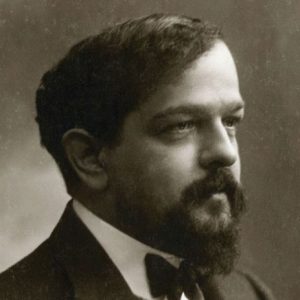Facts About Claude Debussy:
Considera, por favor fazer um donativo ao Artes & contextos.
Ajuda-nos a manter viva e disponível a todos esta biblioteca.
Ajuda-nos a manter viva e disponível a todos esta biblioteca.

- Composers, in general, either spend their lives chasing an unobtainable love, or they make full use of their artistic appeal to women; Debussy was definitely one of the latter. He was always in a relationship with someone and, more often than not, had started a new relationship before ending the previous one.
- After an eight-year affair with one of his singing pupils whose husband was a patron of his, he ‘lived with’ (not really an acceptable thing to do at the end of the nineteenth century) the daughter of a tailor, Gabrielle Dupont – but Debussy cheated on her and got engaged to another girl, Therese Roger instead. He, again, cheated and left her for her friend, Rosalie Texier, who he subsequently married. Rosalie was a model and a seamstress who didn’t really satisfy his intellectual curiosity. Enter Emma Bardac, who did. After getting Emma pregnant, the two of them fled Paris for the Channel Island of Jersey, and then Eastbourne on the south coast of England. Complicated.
- To make matter worse, Debussy was always surrounded by the spectre of suicide which, he himself contemplated regularly. It wasn’t helped by the fact that one of his girlfriends, Gaby Dupont, kept threatening to commit suicide and his wife – once she found out that he’d been cheating on her – attempted suicide in the Place de la Concorde (yes, the place where the guillotine made its bow during the French Revolution a hundred years previously). She chose to shoot herself in the chest and, although she managed it, she survived and then lived another 28 years with the bullet still lodged in her spine.
- Debussy’s relationship with Emma Bardac produced a daughter who they imaginatively named Claude-Emma. Unfortunately, she died a year after Claude in 1919, of diphtheria.

- Debussy died of cancer in 1918 – four days after the first shots of the Battle of the Somme. His funeral took place through the deserted streets of Paris which had been under constant bombardment from distant German guns. He was buried in the Pere Lachaise Cemetery – where, incidentally, Jim Morrison, Edith Piaf and Oscar Wilde were also interred. Unfortunately, damage from subsequent German bombing raids meant that he was later re-interred in the Passy Cemetery after the war had ended.
- Early in his career, Debussy taught piano to Peter Llytch Tschaikovsky’s patroness, Nadezhda von Meck. As was his want, Debussy ‘fell in love’ with one of the daughters and wanted to marry her; but mother wouldn’t allow it. She was, however, impressed with his compositions and sent one of them (Danse Bohemienne) to Tchaikovsky – who, despite thousands of letters between the two of them, and her insistence on giving him a huge annual allowance, he never met; he wasn’t impressed with the young Claude’s composition; ‘It is a pretty piece, but much too short. Not a single idea is expressed fully. The form is terribly shrivelled and it lacks unity’. Debussy’s did prefer his music (like his relationships) to be kept brief.
- Possibly Debussy’s most famous piece is Clair de Lune; it wasn’t written alone, however, as it was the third movement of his Suite Bergamasque which he started in 1890 and didn’t decide was good enough for publication until 1905.
- Debussy is often written about as being an ‘impressionist’ composer – like the visual artists of the time. However, he really didn’t like this term; he preferred to be called ‘modernist’. In response to the term, ‘impressionist’ he once wrote, ‘I am trying to do something different….what imbeciles call Impressionism, a term which is as poorly used as possible – particularly by critics’.
- His full name was Achille Claude Debussy but sometime during the 1890’s, he seems to have dropped the ‘Achille’. He was born to very poor parents in a very wealthy part of suburban Paris; this might explain his loving the good life and always spending above his means.
- When, in 1905, Debussy fled Paris (on account of everyone being quite negative about him for leaving his wife and her subsequent suicide attempt), and ended up in The Grand Hotel in Eastbourne, England which overlooks La Mange (as the English Channel is known in France – it means ‘sleeve’), he had with him the final publishers copies of newly composed piece, La Mer. It is often said that he composed the piece when at the hotel when, in fact, he merely made corrections to the final proofs. But as a point of interest, the English composer, Frank Bridge did compose his own piece entitled, ‘The Sea’, when he stayed at the hotel only six years later in 1911.
- Debussy was a close friend of Erik Satie with whom he shared a love of Parisian café society – bohemians, both, they enjoyed each others company and that of their bohemian friends.
- Debussy’s music wasn’t always universally accepted, but in the US, the symphony orchestras of Boston, New York and Chicago openly championed it in the early years of the twentieth century.
- Debussy’s influences came from far and wide. At the 1889 Paris Expo, there was a group of Javanese musicians invited to play their Gamelan music; Debussy was enthralled with it and was famously quoted as saying it was, ‘..counterpoint by comparison with which Palestrina is child’s play’.
- Debussy’s Bluthner piano (which has been ‘found’ and is still used in occasional concerts of his music today) was originally rented from their agent at an Eastbourne piano store (116 Terminus Road – now a ‘Superdrug’ store). He had it delivered to his room at the Grand Hotel and liked it so much, he bought it and kept it until he died.
- Another major influence in his music is the Russian style of Tchaikovsky, Mussorgsky, Borodin et al – this has attributed to the Franco Russian alliance of the late nineteenth century which fostered cultural ties between the two countries.There had long been ties between the two countries since the French Revolution forced 15,000 emigres to flee and seek refuge there; the Russian court would always welcome royalists into their midst; hence the Russian nobility conversed in French as it was associated with chivalry and high feelings.
O artigo: 15 Claude Debussy Facts – Interesting Facts About Achille Claude Debussy, foi publicado @CMUSE
The post: 15 Claude Debussy Facts – Interesting Facts About Achille Claude Debussy, appeared first @CMUSE
Como classificas este artigo?
Assinados por Artes & contextos, são artigos originais de outras publicações e autores, devidamente identificadas e (se existente) link para o artigo original.







